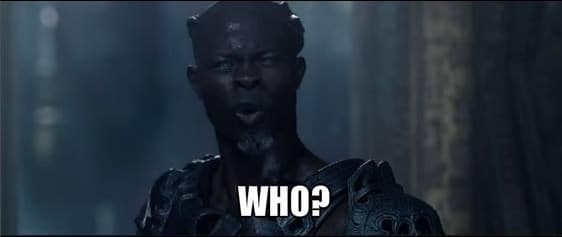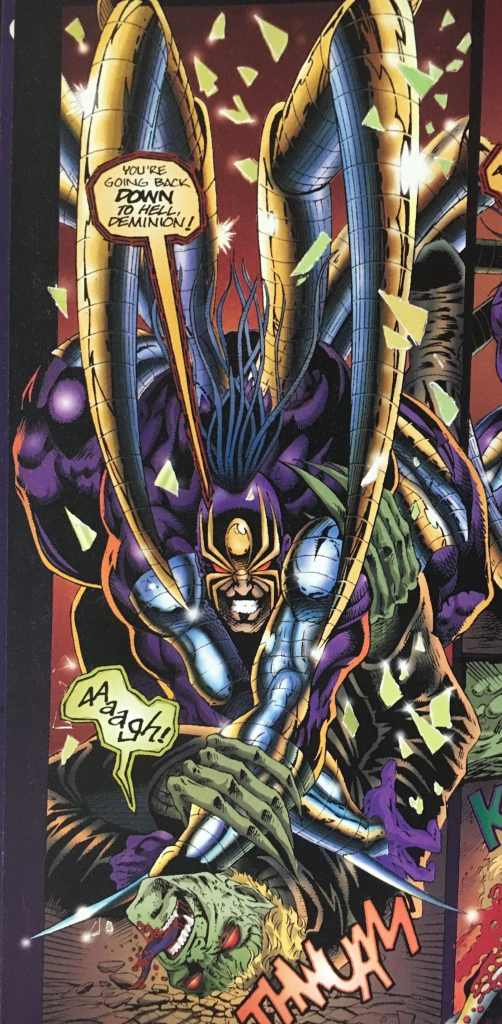Welcome back to another edition of My ‘90s Life, where I spend my time rereading books I either read or wished I had read in the ‘90s rather than doing literally anything more useful or pressing in my life. This week, I’m tackling a deep cut from the mid-1990s that was very popular with my friend group at the time, Araknis.

That’s right, Araknis! Oh, what’s that you say? You’re not familiar with Araknis? That probably means you were too busy reading good comics during this time period or, I don’t know, dating chicks or something. I would honestly be shocked if more than ten people on Twitter or Facebook legitimately remember or read this title from the 90s. I guess I was one of the “cool” kids because there were several of us that thought this comic book was amazing at the time.
Now? Honestly, I don’t remember much, if anything, about the substance of the book before I reread it. The only thing I remembered about Araknis was his design, which was in part aped by Spider-Man during his Iron Spider/Superior phases. I mean, just look at his. Otto Octavius would be jealous!
Araknis was published by Mushroom Comics… or Morningstar Comics… or Mystic Comics. Lots of names there, but no clear indication as to which was really the true publisher. My searches on the interwebs didn’t really clear up the situation much either. The insignia on all of their books definitely labels them as Mushroom Comics, so I’m going with that.
Regardless of the name, the company (companies?) only published four actual titles, none of which lasted more than a few issues, if that many issues: Araknis, Innercircle, Futuretech, and Swarm. As a high schooler, I never heard of the other titles outside of Araknis.
Collecting Araknis at the time was frustrating at best. Despite each miniseries lasting only 4 issues, it took decidedly longer to get issues. The first miniseries (which I’m focusing on here) was released sometime between summer of 1995 through February 1996. Not bad.
The second miniseries was published from April through December 1996. Indie comics were notoriously late during those days, and as a high schooler, I had virtually no concept as to when new issues of anything, indie or otherwise, was hitting the shelves. I just kind of showed up to one of the local shops and lived to be surprised if I saw an issue of something I liked on the rack.
Why Araknis Caught My Eye
I’m not quite sure why my friends and I were so taken with this character, but I can hazard a few guesses. First off, it was an indie comic. Those things were hot, hot, and hot. I mean, how else would we be able to put our future children through college without investing in one of the many issues in the indie glut of the 1990s? Surely, these issues of Araknis would be remembered for being one of the greatest, if not the greatest, works of the medium.
Second, by purchasing an indie comic book, one was exponentially increasing the odds of seeing gore, curse words, and/or nudity. If the book had all three, you just hit teenaged pay dirt!
The last guess? Man, it just looked cool to teenaged Brandon and his friends. It looked cool and extreme. But mainly extreme. Now that I think about, let’s just say extreme. Actually, let’s just knock out all of the awesome 90s terms we probably used to describe this comic at the time to cover all of the bases:
Araknis was: extreme, booyah, radical, extreme, gnarly, most excellent, all that, extreme, tubular, score, extreme, deadly, da bomb, and extreme.
Look, Araknis was extreme. Period. Extreme!
But was it extremely good? Well… let’s find out!
Araknis: Shades of Evil
Let’s get this out of the way: boy that was a rough read. By the end of my reread I had achieved several things, none of them necessarily positive.
First, despite reading this back in ‘95-’96, none of this sparked any memory of reading it at the time. Second, it struck me that, much like my recent rereading of Lady Death, the only reason I probably enjoyed it back in high school was for the fact that it was KEWL and EXTREMMMMME!
Araknis also drove home for me the point that the 90s were not about story at all. If you could draw big muscles, bigger guns, and even bigger, well, you know, bosoms… then BAM! You could have a comic book published.
Araknis was created by the artistic and writing brotherly duo of Michael and Mario Ortiz. If their names aren’t ringing many bells, it’s because they don’t have many books under their publishing belt. Someone like Jason Aaron probably doubles their collective lifetime output on a monthly basis. If one were to count using the time tested Southern Method, you would definitely have enough fingers and toes to get them all with a few digits to spare even if incest is a major part of your own family tree wheel.
Shades of Evil was a four issue miniseries exploring the not-origin of everyone’s not-favorite Superior Spider-Man. Araknis is not the kind of book that’s going to inspire anybody to make any comparisons to Alan Moore. Heck, let’s go so far as to say Chuck Austen might have done a more serviceable job with the material. The miniseries is all over the place. The storytelling is simple, but also muddled to the point of absurdity.
The first two-pages of issues one try to give a ham-fisted origin overview for this completely new character. Some scientist is working on some portal technology, everything goes wrong, and he’s possessed by a spider demon. You know, nothing important. Something that could and should be easily brushed aside with two pages of clunky exposition. You know, the makings of a classic.
The reader is then dropped into the story with little explanation for the motivations of the demon Araknis or his human host (can’t remember his name, can’t be bothered to look it up either). The cold open is also a fine (read: terrible) example of the women in refrigerators trope because the reader is immediately treated to an attempted rape of a young lady by quasi-religious extremists.
Again, it’s not really clear why this is all happening beyond the fact that there’s a rape scene “needed” at the beginning, it’s further creepy-fied by the fact that Araknis also almost eats the woman he saves from being raped.
Araknis is on Earth trying to do… something. Even Araknis’s human host doesn’t know.
- There’s this religious/Satanic group that’s following some guy named Cryptus trying to do… something.
- There’s this police force involved in trying to stop acts of demonic possession and Satanic ritual because… something.
- Araknis gets sent to this other dimensions and is held prison because of… something.
- There’s this other dark lord/demon guy (can’t remember his name, can’t be bothered to look it up either) who is apparently higher up on the bad guy hierarchy than Cryptus who is trying to do… something.
- In the weird demon realm, there’s also a military force fighting Cryptus because of … something.
- Araknis decides to end Cryptus by blowing up the weird demon realm with some type of nuclear grenade in order to achieve… something.

The entire miniseries plays out like a prepubescent action movie, replete with all the clichés and tropes common of almost anything produced in the ‘90s. Araknis was an antihero before being a Spider-themed antihero was cool, except not because Venom was around before Araknis.
As mentioned earlier, Araknis had a cool visual appeal that no doubt was in the back of someone’s mind when developing the Iron Spider concept. He’s a gruff, tough dude because… something. I mean, the title “Shades of Evil” is, like, a Metaphor or something. Get it? He’s a hero but he’s dangerous.
EXTREME!
The Verdict
That. Was. Bad.
Seriously, if I gave out Razzie-esque awards for ‘90s comics, this would be a strong contender for several categories in diminished achievement. The art and story were perfectly 90s. That’s kind of an achievement in and of itself, but not by much.
While I can’t recommend this book for anyone who takes comic books seriously, I could see someone enjoying it if they are a bad movie/comic buff like me. It’s big and dumb. It’s illogical. It’s not something you will think about after you have finished reading.
Full disclosure time: I’m definitely going to check out the second, and final, miniseries. Yes, you read that correctly. The book accomplished one final, improbable act. It has me curious as to where the Ortiz brothers went next. It can’t be much since there’s literally only four more issues after this first miniseries. The company folded in the bust of the mid-90s, and Araknis was banished to the nine hells of 90s obscurity (i.e., the dollar bin).
The fact that it will be a cheap, shallow dive to polish off the rest of the Araknis “saga” makes this an easy target for further reading. I might review it here, I might not. But it will definitely happen.
Onwards! My next ‘90s target will be… Billy Tucci’s SHI! See you then!


